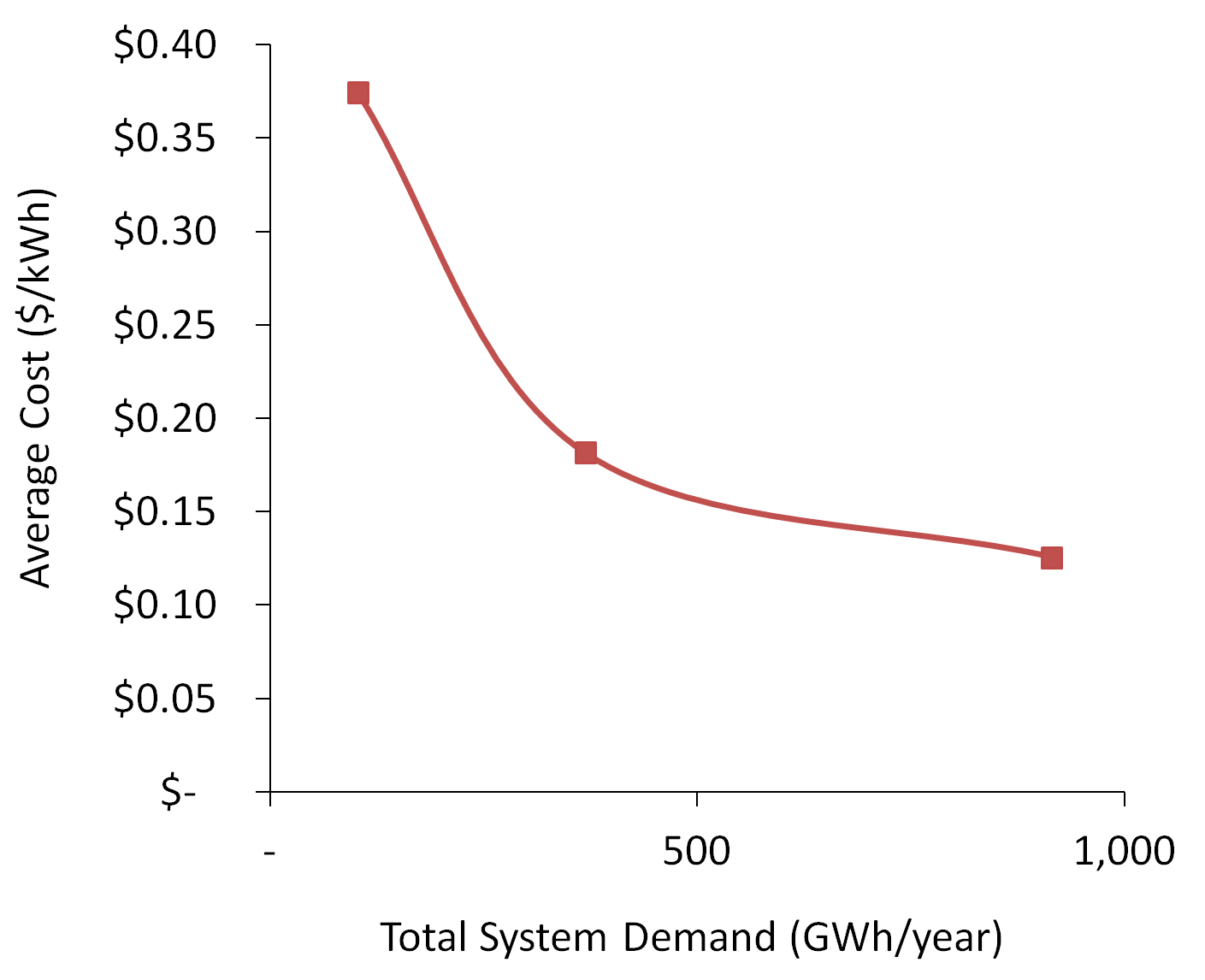If you were planning to open a coffee shop in your neighborhood, you would want to know how many cups your potential customers might consume each day. Underestimating demand for coffee might result in long lines, poor customer service, coffee shortages, and lost potential profits. On the other hand, planning for too much coffee might result in underutilized employees, excess inventory, and higher costs. For coffee shop entrepreneurs and electricity system planners alike, accurately estimating demand is crucial for building the right systems to serve users.
Until now, electricity system planners in emerging economies have primarily relied on simple assumptions and deductive methods for demand forecasting. Optimization models for both large- and small-scale electrification planning show high sensitivity to this input. Better forecasts could help to right-size infrastructure for initial consumption as well as for expected growth. Since governments always face a litany of competing needs, better understanding electricity demand could allow strained budgets to stretch further.
With better forecasts, the same investment can connect more people
Producing better demand forecasts promise to enable better resource allocation, faster returns on investment, and decreased risk for private financing. As the global community is projected to fail in achieving universal electricity access by 2030,1 improved planning may provide a much needed boost to progress.2
Current demand characterization methods leave room for improvement:
- Assuming fixed demand or linear trends. The most common demand forecasting methodology is to assume that demand is fixed over a planning horizon.3 The most popular alternative is to assume a constant growth rate, perhaps based on historical data. These assumptions conflict with empirical data on how consumption typically grows. For example, Fobi et al. depict characteristic consumption growth curves in Kenya that tend to saturate over 5 year durations (Figure 1).4
- Using deductive approaches. More sophisticated methods that are less commonly used include system dynamics and input-output models. While these approaches may be informative, they may have difficulty mimicking historical data when applied in practice and can be inappropriate for contexts involving concrete investments.5
- Estimating demand is inherently tough. When considering energy access, populations of interest may have never previously had electricity. This makes it difficult to predict latent demand – what their consumption would be if reliable and affordable access to electricity was available. Though comparing non-electrified areas to those that were previously electrified is a promising way forward, data on historical consumption are often disorganized or nonexistent. Historical data may also be misleading as new customers often have different growth trajectories from those previously connected. Additionally, factors like affordability, price, reliability, potential for productive uses, and culture complicate data-driven approaches.
Demand estimates can substantially impact how systems are built
- The effects on planning for small-scale systems are well documented. Numerous studies have shown that demand assumptions have significant impacts on off-grid designs. When designing a 3 kWp system in Zanzibar, Kivaisi noted that, “the most important part of the planning process is determining the electric energy demand as accurately as possible.”6
- Large-scale electrification models corroborate. Studies using the MIT-Comillas Universal Energy Access Lab’s Reference Electrification Model (REM) corroborate this sentiment at large scales. REM plans detailed and cost-optimal system designs choosing supply technologies including grid extensions, mini-grids, stand-alone systems, and solar kits. As shown in Figure 2, costs reflected in optimal plans can vary up to several multiples of baseline costs, given ranges of demand assumptions.7
How should the development community respond?
- Planners should lean toward overestimating demand. Simply accounting for expected values of demand is not enough if demand growth is uncertain. System planners and decision-makers may be incentivized to plan for demand that is slightly larger than what is expected if the social costs of oversizing a system (financial stress on the provider) outweigh those of undersizing (constraining consumption and worsening poverty).
- Flexibility of supply should be highly valued. The flexibility inherent in choices of supply technologies should be assessed as well. For example, if a mini-grid is the cost-optimal mode of servicing a population but there is significant uncertainty with regards to how fast demand will grow, it may make sense to ensure that these mini-grids are “grid-compatible” and to ensure regulation is in place to allow for connection to the main grid at a later date. Although ensuring grid-compatibility may cost more upfront, investing in the “real option” to connect to the grid may be worthwhile.8
- Invest in better data for demand forecasting. Numerous research organizations have begun concerted efforts to improve demand forecasting methods for developing countries. The e-GUIDE initiative and the MIT-Comillas Universal Energy Access Lab have launched promising programs aimed at using detailed consumption data, demographic features, satellite imagery, and machine learning to estimate and forecast latent demand for electricity.9,10
- Find ways to stimulate demand. Significant economies of scale are achieved as demand increases (Figure 2). Discovering, recommending, and quantifying the effects of techniques to stimulate demand (e.g. by introducing targeted subsidies, launching appliance financing programs, etc.) can improve the financial viability of electrification projects and further expedite progress. While it may seem counterintuitive, demand forecasting and demand stimulation can be complementary endeavors. Machine learning methods may be able to forecast demand conditioned on whether or not interventions are made. Moreover, they may help to identify promising interventions to improve outcomes at the systems-level.
FIGURE 1: Characteristic consumption growth curves for grid-connected Kenyan consumers

FIGURE 2: Three cost-optimal plans generated by the Reference Electrification Model (REM). As demand increases average costs decrease significantly

Endnotes
- IEA, World Energy Outlook 2018, IEA, Paris, https://doi.org/10.1787/weo-2018-en.
- IEA, World Energy Outlook 2018, IEA, Paris, https://doi.org/10.1787/weo-2018-en.
- Riva, Fabio, et al. “Long-term energy planning and demand forecast in remote areas of developing countries: Classification of case studies and insights from a modelling perspective.” Energy strategy reviews 20 (2018): 71-89.
- From data used in Fobi, Simone, et al. “A longitudinal study of electricity consumption growth in Kenya.” Energy Policy 123 (2018): 569-578.
- P. Gretton, “On input-output tables: uses and abuses,” Productivity Commission Staff Research Note, Australian Productivity Commission, 2013.; C. R. Featherston, M. Doolan and others, “A critical review of the criticisms of system dynamics,” in Proceedings of the 30th International Conference of the System Dynamics Society, St. Gallen, Switzerland, 2012.
- Kivaisi, Rogath T. “Installation and use of a 3 kWp PV plant at Umbuji village in Zanzibar.” Renewable energy 19.3 (2000): 457-472.
- Ciller, Pedro, et al. ” Optimal Electrification Planning Incorporating On- and Off-Grid Technologies: the Reference Electrification Model (REM).” Proceedings of the IEEE. doi:10.1109/JPROC.2019.2922543; IEA, World Energy Outlook 2018, IEA, Paris, https://doi.org/10.1787/weo-2018-en.
- Lee, Stephen J. “Adaptive Electricity Access Planning.” Massachusetts Institute of Technology (2018); De Neufville, Richard, and Stefan Scholtes. Flexibility in engineering design. MIT Press, 2011.
- The Electricity Growth and Use in Developing Economies (e-GUIDE) Initiative, web: https://eguide.io/; e-GUIDE is a partnership of groups at four universities: the University of Massachusetts – Amherst, Carnegie Mellon University, Columbia University, and Colorado School of Mines
- The MIT-Comillas Universal Energy Access Lab, web: http://universalaccess.mit.edu
- From data used in Fobi, Simone, et al. “A longitudinal study of electricity consumption growth in Kenya.” Energy Policy 123 (2018): 569-578. Graph created using data from customers who connected between 2009 and 2015.
- Lee, Stephen, et al., “Investigating the Necessity of Demand Characterization and Stimulation for Geospatial Electrification Planning in Developing Countries” MIT Center for Energy and Environmental Policy Research (2019)

